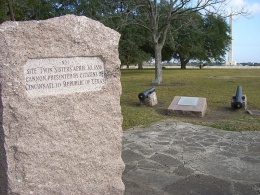Smoothbore
Smoothbore refers to a firearm or cannon which does not have a rifled barrel.
[edit] History of firearms and rifling
Early firearms had smooth barrels, and fired projectiles with no significant spin. These projectiles had to be stable shapes, such as finned arrows or spheres, to minimize tumbling during flight. However, spherical bullets do tend to rotate randomly during flight, and the Magnus effect means that even a relatively smooth sphere will curve when rotating on any axis not parallel to the direction of travel (like a knuckleball, for example).
Rifling imparts a spin to the projectile, which stabilizes it and prevents it from tumbling. This does two things; first, it increases the accuracy of the projectile by eliminating the random drift due to the Magnus effect, and second, it allows longer, heavier bullets to be used from the same diameter barrel, increasing range and power (see external ballistics). In the 18th century, the standard infantry arm was the smoothbore musket; by the 19th century, rifled barrels became the norm, increasing the power and range of the infantry weapon significantly.
[edit] Modern smoothbores
Some firearms are still made smoothbore. The most common of these is the shotgun. Firing multiple, non-coaxial projectiles out of a rifled barrel would result in an "O" shaped pattern, with a very rapid spread, leading to a high projectile density on the periphery, and a low projectile density in the interior. While this may be acceptable at close ranges (some spreader chokes are rifled to produce wide patterns at close range) this is not desirable at longer ranges, where a tight, consistent pattern is required to maximize the probability of hitting the target.
The cannon, in the form of the tank gun, has made the transition from smoothbore to rifled and is moving back to smoothbore. To reliably penetrate the thick armor of modern armored vehicles, a very long, thin kinetic energy projectile is required. The longer the projectile is in relation to its diameter, the higher the twist rate must be to provide stability. Practical rifling can only stabilize projectiles of a certain length to diameter ratio, and these modern rounds are just too long. These rounds are instead formed into a dart shape, using fins for stabilization (see kinetic energy penetrator for information on how this works). With the fins for stability, rifling is no longer needed and in fact the spin imparted by rifling will degrade the accuracy of a finned projectile. Because of the increasing use of the highly effective kinetic energy penetrator projectiles by tank guns, many modern tanks have smoothbore barrels. The Russian navy also experimented with smoothbore large caliber navy guns, but budget cuts halted the progress.
The tank gun evolution has also shown up in small arms, particularly the Advanced Combat Rifle (ACR) program. The ACR "rifles" used smoothbore barrels to fire single or multiple flechette per round, rather than bullets, to provide long range, flat trajectory, and armor piercing abilities. Just like the kinetic energy penetrator rounds for tanks, the flechette are too long and thin to be stabilized by rifling and perform best from a smoothbore barrel. The ACR program was abandoned due to reliability issues and poor terminal ballistics.
Another smoothbore weapon in use today is the 37 mm riot gun. These are used at short ranges against groups of people, therefore a high degree of accuracy is not required.
Mortars are often smoothbore; since the projectile is dropped down the barrel under the force of gravity, a smooth barrel makes the projectile easier and faster to load. Smoothbore mortars use fin stabilized projectiles.
[edit] Legal issues
Firearms with bore diameters greater than .5 inches (12.7 mm) that have rifled barrels are generally considered to be destructive devices under the National Firearms Act in the United States, and are thus heavily regulated. The exception to this are shotguns with rifled barrels for firing in shotgun slugs. In Canada, a firearm that surpasses the max velocity of 500f/s is considered a weapon.
